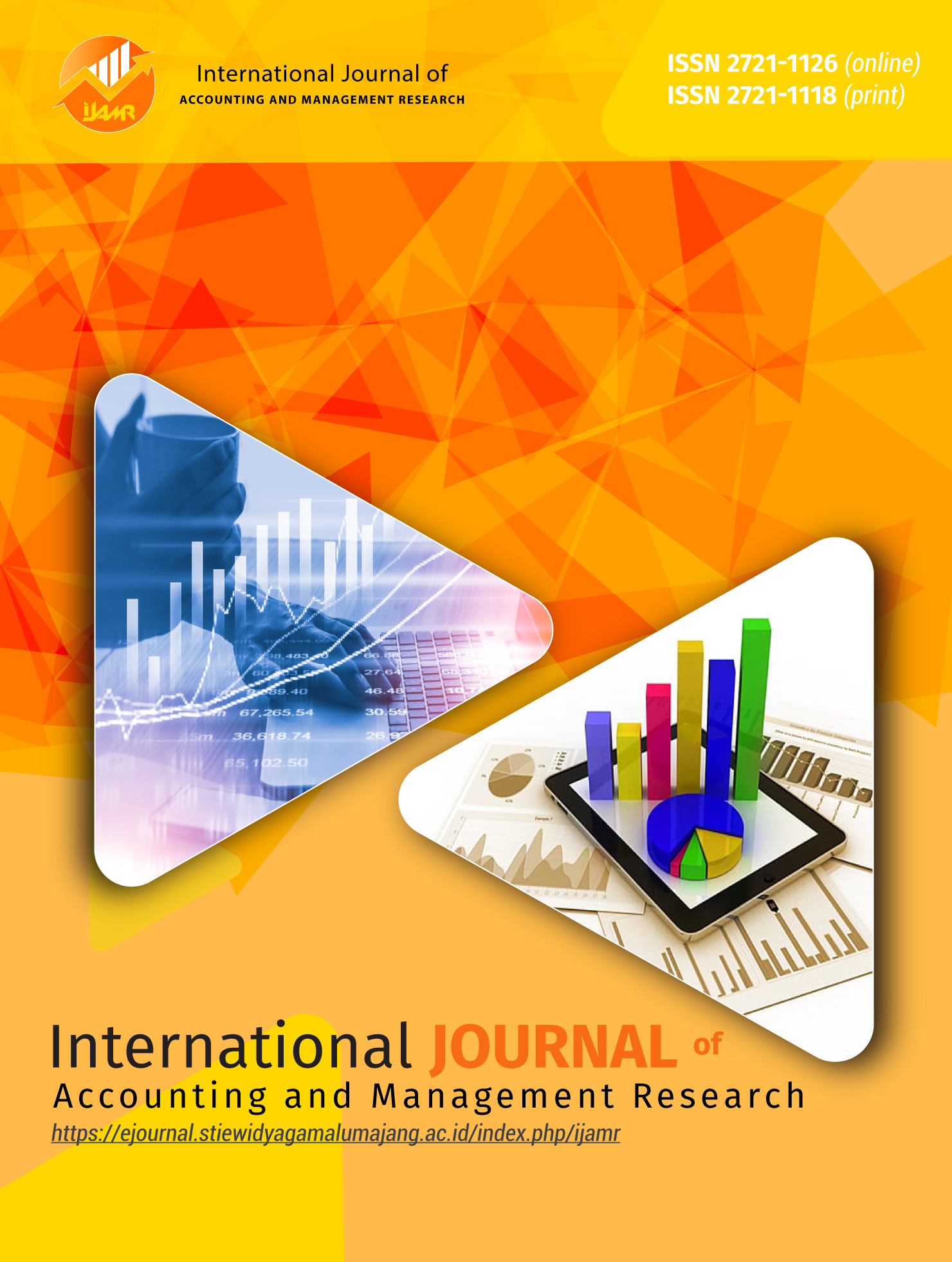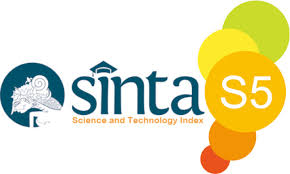Village Funds and Corruption Tendencies in Village Development
DOI:
https://doi.org/10.30741/ijamr.v5i2.1421Keywords:
Corruption Tendency, IDM, Realization, Village FundAbstract
This study aims to analyze the effect of village funds and the tendency of corruption on village development in Central Sulawesi Province. This study uses village government data in Central Sulawesi Province. Using the Proposive Sampling method for sample selection, so that the total final sample obtained was 1,840 observations. The results showed that village funds and corruption tendencies had an impact on increasing the village development index (IDM). Related to the existence of control variables, the characteristics of the village head and village characteristics also show an influence on increasing IDM. This research has implications for the importance of supervision and efforts to eradicate corruption at the village level to increase IDM
References
A. Amir, et al. (2021). The role of budget participation in improving managerial performance. Journal of management and Business Studies, 10(2), 123-134.
Abbott, P., & Sand, S. P. (2020). Political regimes, corruption and development aid targeting. European Economic Review, 121, 103315.
Ababil, Rega, Miryam Alawiyah, and Atikah Atikah. 2024. “Effective Investment Strategies: Understanding The Investment Process and Types of Securities.” Magister: Manajemen Strategis Dan Terapan 1 (1): 20–29.
Ismiantika, Ismiantika, Prayudi Ika Susandy, and Margo Yuwono. 2024. “Bankruptcy Prediction: A Literature Review Of Enterprise Risk Management (ERM) Approaches Financial Management Review.” Magister: Manajemen Strategis Dan Terapan 1 (1): 7–19.
Mahmudah, Syahriatul, Widi Lstiyas Rini, and Aditya Maulana Majid. 2024. “The Role of Portfolio Theory in Risk Management and Investment Decision Making.” Magister: Manajemen Strategis Dan Terapan 1 (1): 30–36.
Mutho, Asyfiq, Fifin Wulan Lestari, Nadia Aviana Sari, and Yusril Ihza Mahendra. 2024. “Knowledge and Explanation of Capital Markets in General to Deepen the Insight of Economic Studies.” Magister: Manajemen Strategis Dan Terapan 1 (1): 1–6.
Anam, C., Plaček, M., Valentinov, V., & Del Campo, C. (2023). Village funds and poverty reduction in Indonesia: new policy insight. Discover Global Society, 1(1). http://doi.org/10.1007/s44282-023-00016-6
Annisa, A. N. (2020). Pengaruh Karakteristik pemerintah daerah terhadap kinerja keuangan pemerintah daeraah pada kabupaten/kota di Indonesia. Jurnal Akuntansi Pemerintah, 5(3), 231-245.
Awofeso, O., & Odeyemi, T. I. (2014). The impact of political leadership and corruption on Nigeria’s development since independence. Journal of Sustainable Development, 7(5), 240–253. http://doi.org/10.5539/jsd.v7n5p240
Chambers, R. (2022). Paradigms, poverty and adaptive pluralism. Development Southern Africa, 39(5), 545-573.
Dewi, S. E., Hermawati, H., & Haris, M. (2022). Pengaruh Indeks Desa Membangun (IDM) terhadap peningkatan perekonomian masyarakat di Desa Singosari Kecamatan Dlima Kabupaten Malang. Jurnal Sosial Ekonomi dan Pembangunan Pedesaan, 4(1), 1-9.
Din, M., et al., (2024). Peningkatan akuntabilitas desa melalui pendampingan penyusunan laporan keuangan di desa Tamarenja. Jurnal Akuntansi Desa, 11(4), 189-401.
Fujita, M., & Thisse, J. F. (2020). Economics of agglomeration: Cities, industrial location, and globalization. Cambridge University Press.
Furgan, F., Sari, D. P., & Agustin, N (2023). The impact of village Fund allocation and corruption on village development. Journal of Rural Developmet, 15(2), 123-145.
Graham, D., Balcells, L., & Hicks, R. (2023). The domestic determinants of development cooperation strategies. Journal of Conflict Resolution, 67(1), 3-33.
Gunawan, A., et al. (2023). Efektivitas metode pencegahan dan pendeteksi kecurangan (fraud). Jurnal audit dan Keuangan, 15(2), 145-160.
Handayani, B., Suryono, A., & Sujarwoto. (2021). The role of village funds allocation in improving village infrastructure development. Journal of Local Government studies, 18(1), 67-89.
Herawati, H., Nurlaila, L., & Wulandari, T. L. (2021). Analisis faktor-faktor yang mempengaruhi indeks desa membangun (IDM) di Kecamatan Dlima Kabupaten Malang. e-Prosiding SNEEK Nasional VIII Tahun 2021, 1, 623-634.
Imawan, S. A., & Purwanto, E. A. (2020). Governing Village Fund in Indonesia: Is It Erradicating Poverty? Policy & Governance Review, 4(1), 14. http://doi.org/10.30589/pgr.v4i1.169
Joetarto, B., Setiawan, A., & Farida, F. (2020). The Impact of Village Fund Program on Improving Well-being. Jejak, 13(2), 345–366. http://doi.org/10.15294/jejak.v13i2.24395
Kementerian Keuangan. (2020). Buku Saku Dana Desa. Kementerian Keuangan Republik Indonesia
Kementerian Desa, Pembangunan Daerah Tertinggal, dan Transmigrasi. (2015). Peraturan Menteri Desa, Pembangunan Daerah Tertinggal, dan Transmigrasi Nomor 21 Tahun 2015 tentang Penentapan Prioritas Penggunaan Dana Desa. Kementerian Desa, Pembangunan Daerah Tertinggal, dan Transmigrasi Republik Indonesia.
Klitgaard, R. (2019). Controlling Corruption. University of California Prees.
Komisi Pemberantasan Korupsi. (2022). Mengawasi Dana Desa: Upaya Pencegahan Korupsi di Tingkat Desa. Komisi Pemberantasan Korupsi Republik Indonesia
Made, N., et al. (2021). Revealing the sprit value of prajuru behavior in disclosing financial statements as a form of accountability for Banjar Sekar Sari in Palu City. Journal of Accounting and Finance, 13(1),98-112.
Martinez-Bravo, M., Mukherjee, A., & Stegmann, A. (2022). The non-democratic roots of democratic success. Econometrica, 90(6), 2517-2552
North, D. C. (1981). Structure and change in economic history. New York: W.W. Norton & Company.
Patnaik, U., Shankar, B., & Das, M. (2022). Governance, corruption and welfare spending in India. World Development, 151, 105855.
Peraturan Pemerintah Republik Indonesian Nomor 8 Tahun 2016 tentang Perubahan Kedua atas Peraturan Pemerintah Nomor 60 Tahun 2014 tentang Dana Desa yang Bersumber dari Anggaran Pendapatan dan Belanja Negara.
Pranowo, E., Pranata, S. M., & Wahono, H. S. (2022). Community Participation in The Formulation of Village Regulations in Relation to Village Development Index (Case Study in District Karangploso, Malang Regency). Yuridika: Jurnal Ilmu Hukum, 37(1), 40-51.
Putri, C. M., Argilés-Bosch, J. M., & Ravenda, D. (2023). Thirty Years of Village Corruption Research: Accounting and Smart Villages for Village Sustainability as Future Research Direction. Sustainability (Switzerland), 15(12). http://doi.org/10.3390/su15129264
Rasyid, A., & Wicaksono, R. H. (2022). Pengaruh Transparansi, Akuntabilitas dan Partisipasi Masyarakat Terhadap Penyalahgunaan Dana Desa. Jurnal Akuntansi, Manajemen Bisnis Dan Teknologi STIE IBBI, 3(1), 49–58.
Republik Indonesia Tahun 2014 Nomor 7. Jakarta: Sekretarian Negara.
Ristanto, B., Bawono, P. G., & Respati, H. (2020). Village Funds and poverty alleviation: A regression discontinuity design evidence from Indonesia. Economies, 8(4), 83.
Ross, A., Saluja, D., & Patel, J. (2022). Rural development through decentralized village governance: Evidence from India's village funds. World Development, 151, 105840.
Roy, S., & Sabharwal, L. (2020). The long-run impacts of corruption: Evidence from India. American Economic Journal: Applied Economics, 12(4), 193-222.
Sari, S. (2021). Pengelolaan Dana Desa: Teori dan Praktik. Jurnal administrasi public, 9(1), 55-68.
Schumacher, E. F. (1973). Small is beautiful: Economics as if people mattered. London: Blond & Briggs.
Sileng, F. S., Lubis, B., & Siradj, S. (2020). Pengaruh indeks desa membangun (idm) terhadap pendapatan perkapita masyarakat di Desa Karya Jaya Kecamatan Sidikalang Kabupaten Dairi. Jurnal Ekonomi Bisnis, 25(2), 152-161.
Smith, A. (1937). The wealth of nations [1776] (Vol. 11937). na.
Sudirman, S., Anwar, M., & Indrawati, Y. (2022). Corruption in village funds management: Challenges and strategies for prevention. Jurnal Kebijakan Publik, 9(3), 201-220.
Sulistyorini, D., & Hafiar, A. (2023). Factors Affecting Village Fund Allocation in Indonesia. Jentera Sosial: Jurnal Pengabdian Kepada Masyarakat, 6(1), 11-20.
Sultana, N., Khatun, F., & Ali, M. Y. (2024). Factors influencing sustainable rural development in Bangladesh: An application of integrated rural development approach. Sustainability, 12(3), 1109.
Sunarsi, D., Maddinsyah, A., & Setyawati Kristianti, L. (2021). Analysis of the Effectiveness of Village Funds in Independent Village Development Efforts (Study at Cidokom Village, Gunung Sindur, Bogor Regency). Proceedings of the 1st International Conference on Research in Social Sciences and Humanities (ICORSH 2020), 584(Icorsh 2020), 195–203.
Sutaryo, F.X.R., & Faisal, A. (2021). Analisis Dampak Dana Desa Terhadap Peningkatan Infrastruktur di Kabupaten Banyumas. Jurnal Ilmiah Ilmu Administrasi Publik, 7(2), 69-77.
Sutrisno, A., Wahyudi, W., & Sukmana, R. (2020). Optimizing the use of village funds for sustainable village development. Journal of Regional and Rural Development Planning, 4(2), 101-118.
Undang-Undang Republik Indonesia Nomor 6 Tahun 2014 tentang Desa. Lembaran Negara
Wardhana, A. (2020). Faktor-Faktor yang Mempengaruhi Penyalahgunaan Dana Desa (Studi Kasus di Kabupaten Blora). Jurnal Administrasi Publik, 8(1), 57–64.
Wibowo, A., Putra, A. R., & Supriyadi, Y. (2021). The influence of village fund Realization and corruption tendency on village development index. Jurnal Ilmu administrasi Publik, 9(2), 125-134.
Yusnita, N. (2018). Pengelolaan Keuangan desa dalam cerminan budaya Sintuvu Maros. Jurnal Keuangan Desa, 8(1), 77-89.
Downloads
Published
How to Cite
Issue
Section
License

This work is licensed under a Creative Commons Attribution-NonCommercial 4.0 International License.











